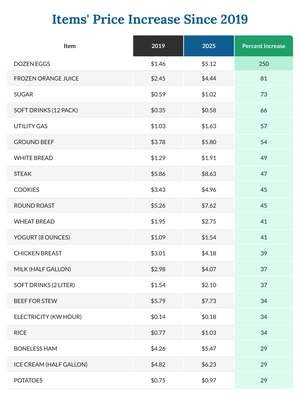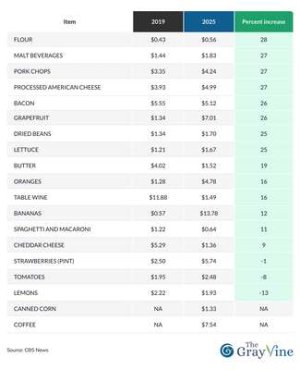Inflation hits 2.3% in April, CPI report reveals—What it means for you
- Replies 0
Inflation remains a concern, but the latest data shows a slight slowdown in the price increases that have been impacting everyday goods.
While costs for housing and energy continue to climb, there are small signs of relief, especially in the grocery aisle.
With trade tensions and tariff decisions still in play, the road ahead for consumer prices remains uncertain, and the Federal Reserve is keeping a close eye on how it all unfolds.
The Consumer Price Index (CPI) for April rose by 2.3% compared to last year, which was slightly below economists' expectations but still shows inflation remains above the Federal Reserve's 2% target.
While economists had predicted a 2.4% increase in the CPI, the actual rise came in lower, marking the smallest jump since February 2021.
On a month-over-month basis, the CPI increased by just 0.2%, under the expected 0.3%.
A major factor behind the rise in prices was housing, with energy costs also climbing, despite lower gasoline prices.

Grocery prices showed a slight dip, down 0.1%, with egg prices falling 12.7% to $5.12 per dozen, although they are still significantly higher than a year ago due to ongoing bird flu outbreaks.
Economists are now paying close attention to the effects of President Trump's tariffs, which are expected to drive up consumer prices.
Tariffs are essentially taxes on imported goods, which businesses often pass on to shoppers, causing price hikes.
Federal Reserve Chair Jerome Powell has said the Central Bank is taking a wait-and-see approach on tariffs, acknowledging that they could push inflation up and slow down economic growth.
But, for now, the impact of these tariffs has yet to be fully reflected in the data.
Trump has rolled out tariffs and even delayed or reduced them, as seen with the April 9 decision to scale back import duties on Chinese-made goods.
The temporary tariff reduction could soften some of the inflationary pressure, but the impact won’t be felt immediately, as many businesses rushed to place orders ahead of the tariff deadlines.
As a result, economists expect the effects of tariffs to show up in the data a few months down the road.
Julien Lafargue, chief market strategist at Barclays Private Bank, noted, "In reality, the data for April is likely to be largely unaffected by President Trump's announcements on Liberation Day."
He added that exemptions were granted for goods already en route before the tariff changes, and businesses rushed to beat the new duties in February and March. Therefore, it may take some time before the full impact of trade uncertainties is seen in consumer prices.
With a recent easing of tariffs and inflation not expected to rise as quickly as previously thought, analysts are adjusting their predictions.
EY’s Daco has lowered his CPI forecast for the year to 3.2%, down by 0.4 percentage points.
While inflation is still anticipated to pick up later in the year, it will likely do so at a slower pace. This could lead the Federal Reserve to reduce interest rates twice in 2025, with the first cut possibly occurring in September instead of July.
The cooler-than-expected data for April might give the Fed some breathing room to hold off on rate cuts for now.
Carl Weinberg, chief economist at High Frequency Economics, explained, "The Fed can stand still on rate hikes and cuts based on this data while it patiently waits to see the impact of erratic policy changes on prices in the months ahead."
For consumers and businesses, this means they might have to wait a little longer for relief from high borrowing costs, as the Federal Reserve’s actions directly affect the interest rates banks and lenders charge.

How have you noticed inflation affecting your everyday purchases in the past month? What changes would you like to see in government policies to help reduce the impact of inflation on consumers? Share your thoughts in the comments below!
While costs for housing and energy continue to climb, there are small signs of relief, especially in the grocery aisle.
With trade tensions and tariff decisions still in play, the road ahead for consumer prices remains uncertain, and the Federal Reserve is keeping a close eye on how it all unfolds.
The Consumer Price Index (CPI) for April rose by 2.3% compared to last year, which was slightly below economists' expectations but still shows inflation remains above the Federal Reserve's 2% target.
While economists had predicted a 2.4% increase in the CPI, the actual rise came in lower, marking the smallest jump since February 2021.
On a month-over-month basis, the CPI increased by just 0.2%, under the expected 0.3%.
A major factor behind the rise in prices was housing, with energy costs also climbing, despite lower gasoline prices.

The annual inflation rate in April rose by 2.3%, less than economists had expected, signalling a slight easing in consumer price pressures. Image source: Engin Akyurt / Unsplash.
Grocery prices showed a slight dip, down 0.1%, with egg prices falling 12.7% to $5.12 per dozen, although they are still significantly higher than a year ago due to ongoing bird flu outbreaks.
Economists are now paying close attention to the effects of President Trump's tariffs, which are expected to drive up consumer prices.
Tariffs are essentially taxes on imported goods, which businesses often pass on to shoppers, causing price hikes.
Federal Reserve Chair Jerome Powell has said the Central Bank is taking a wait-and-see approach on tariffs, acknowledging that they could push inflation up and slow down economic growth.
But, for now, the impact of these tariffs has yet to be fully reflected in the data.
Trump has rolled out tariffs and even delayed or reduced them, as seen with the April 9 decision to scale back import duties on Chinese-made goods.
The temporary tariff reduction could soften some of the inflationary pressure, but the impact won’t be felt immediately, as many businesses rushed to place orders ahead of the tariff deadlines.
As a result, economists expect the effects of tariffs to show up in the data a few months down the road.
Julien Lafargue, chief market strategist at Barclays Private Bank, noted, "In reality, the data for April is likely to be largely unaffected by President Trump's announcements on Liberation Day."
He added that exemptions were granted for goods already en route before the tariff changes, and businesses rushed to beat the new duties in February and March. Therefore, it may take some time before the full impact of trade uncertainties is seen in consumer prices.
With a recent easing of tariffs and inflation not expected to rise as quickly as previously thought, analysts are adjusting their predictions.
EY’s Daco has lowered his CPI forecast for the year to 3.2%, down by 0.4 percentage points.
While inflation is still anticipated to pick up later in the year, it will likely do so at a slower pace. This could lead the Federal Reserve to reduce interest rates twice in 2025, with the first cut possibly occurring in September instead of July.
The cooler-than-expected data for April might give the Fed some breathing room to hold off on rate cuts for now.
Carl Weinberg, chief economist at High Frequency Economics, explained, "The Fed can stand still on rate hikes and cuts based on this data while it patiently waits to see the impact of erratic policy changes on prices in the months ahead."
For consumers and businesses, this means they might have to wait a little longer for relief from high borrowing costs, as the Federal Reserve’s actions directly affect the interest rates banks and lenders charge.
Key Takeaways
- The annual inflation rate in April rose by 2.3%, less than economists had expected, signaling a slight easing in consumer price pressures.
- Housing and rising energy costs were the main drivers of last month’s inflation, while grocery prices – including eggs – actually fell modestly.
- The full effects of Mr Trump's tariffs have yet to show up in the data, with economists noting any impact on consumer prices may not appear for a few more months.
- April’s cooler-than-expected inflation figures may allow the US Federal Reserve to delay interest rate cuts, providing more time to assess the economic effects of trade policy changes.
How have you noticed inflation affecting your everyday purchases in the past month? What changes would you like to see in government policies to help reduce the impact of inflation on consumers? Share your thoughts in the comments below!








